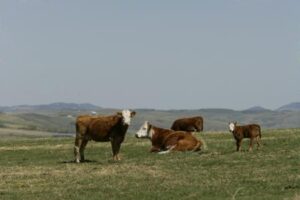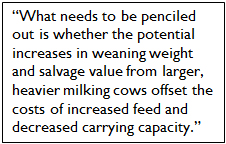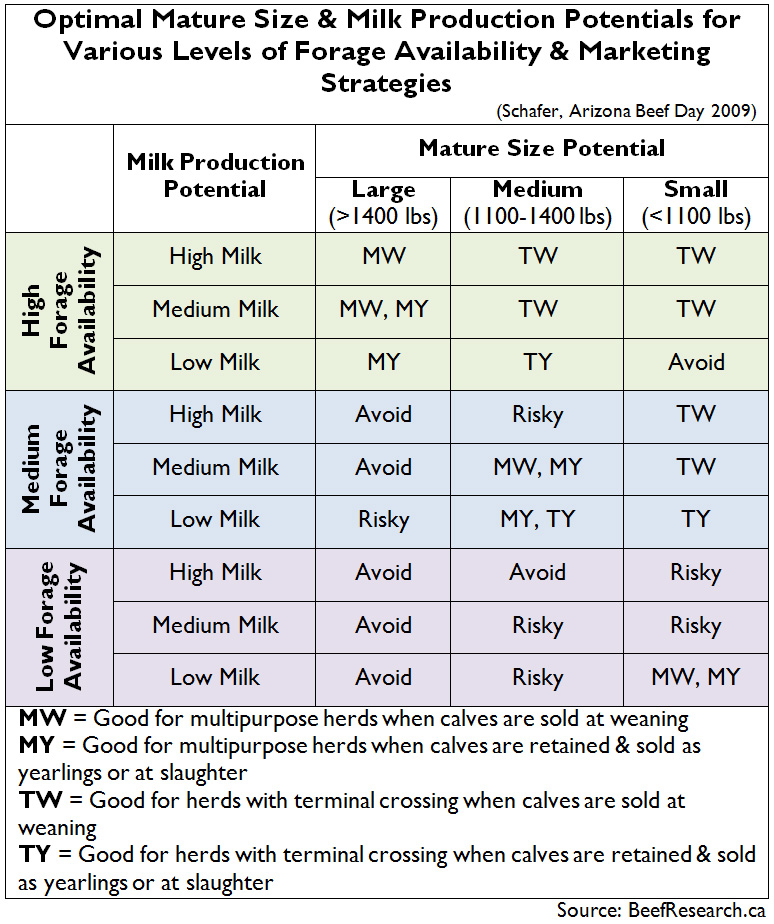Bigger Is Not Always Better: Finding the Right Sized Cow
This is a guest post written by Karin Schmid, Beef Production Specialist with the Alberta Beef Producers.
Marketing cows because they are open, calved late, or their conformation is breaking down are easy decisions. Marketing cows or retaining heifers based on productive efficiency definitely requires more thought.
Biological efficiency is not always the same as economic efficiency. In a cattle production system, efficiency is often a combination of those two measures. How we optimize efficiency will depend on:
- the genetic potential of the cowherd,
- the environment in which the cattle are raised, and
- the marketing strategy utilized by the producer.
Selection for the type of cattle that perform best in the feedlot (i.e. produce the most amount of beef in the shortest period of time) may not produce the ideal replacement animals in a grazing environment, yet selection for improved growth rates has increased average mature cow weights from 1000 lbs to 1400 lbs over the last 30 years (Weaber, Cornbelt Cow-Calf Conference 2012). Almost all producers underestimate the size of their cows, unless or until they weigh them.

Maintaining herd performance records can take some of the guesswork out of defining which cows are efficient producers. Adjusted 205 day weaning weights remove the age bias and are quite useful in a tight calving period. However, during long-drawn out calving seasons (which are inherently inefficient) adjusted weaning weights will tend to favour light, late born calves – that may or may not continue to grow the way the adjustment predicts.
Determining cow productive efficiency by using weaning weight as a percentage of cow body weight is definitely biased towards smaller cows, and not a true measure of efficiency. An 1100 lb cow weaning 60% of her body weight weans a 660 lb calf. A 1400 lb cow that weans at 50% of her body weight is weaning a calf that is 40 lbs heavier. Heavier cows tend to wean heavier calves, and a heavier cow will bring more at auction when it is time to ship her.
But a heavier cow means increased maintenance requirements for feed, and the same amount of pasture will carry fewer big cows than smaller cows. This is not a linear relationship, however. Increasing cow weight by 27% (from 1100 lbs to 1400 lbs, assuming a high lactation level for both weight classes) only increases maintenance requirements by 20% (NRC, 2000); for that reason, seventy-eight 1400 lb cows require about the same amount of feed for maintenance as ninety-three 1100 lb cows (Johnson, BIF 2010).
The total feed energy required increases as cows get bigger, but the amount of energy required per lb of body weight actually decreases, making a 1400 lb cow 5.5% more efficient than an 1100 lb cow, assuming similar milk production (Hamilton, Virtual Beef 2010; NRC, 2000). Perhaps obviously, cows with higher genetic potential for milk production will have increased maintenance requirements, but also produce a heavier calf at weaning.

What needs to be penciled out is whether the potential increases in weaning weight and salvage value from larger, heavier milking cows offset the costs of increased feed and decreased carrying capacity. The answer here depends almost entirely on the environment (quality and quantity of forage resources), cost of supplemental winter feed, and marketing strategy.
In the table below, we can see that heavier milking, bigger cows are more efficient in some situations, while moderate, lighter milking cows are more efficient in others. A similar table can be found in the latest Beef Improvement Federation Guidelines.
Environments such as the shortgrass parts of the country favour small to moderate cows without extreme milk production, while the parkland region tends to favour larger, heavier milking cows. An early Agriculture Canada study (Smith, 1987a,b) illustrates this point. In Brandon, MB, a fertile area where feed resources were abundant, heavy milkers were the most profitable cows. However, in the Manyberries, AB area, where feed resources were more limited and the environment more stressful, light to moderate milkers proved to be the most profitable.

Feed efficiency is one trait that has the ability to dramatically influence the type of cows you match to the environment. A big cow may eat the same as a smaller cow while raising the same size calf and maintaining the same reproductive cycle and body condition. The way that cows utilize feed (especially in pasture or forage situations) has not been studied to the same extent as feed efficiency in feeder animals.
A project funded by the Alberta Beef Producers (ABP) intends to provide a reliable method of measuring feed efficiency in replacement heifers by comparing residual feed intake (RFI) measurements in confinement and on pasture, while also quantifying the relationship of RFI with first calving fertility and productivity.
Another project funded by ABP and the Beef Cattle Research Council (BCRC) under the 2nd Beef Cattle Industry Science Cluster aims to demonstrate how to build a feed efficient cowherd, without sacrificing reproductive performance and maintaining or improving progeny carcass traits. Results are expected in 2016.
There is more to cow efficiency than size, and while bigger is not always better, it might be in some situations. Selecting cows that are the best fit for their environment, available resources, and your marketing strategy will optimize production efficiency and improve profitability.
Factors to Consider
- What do my cows actually weigh?
- Are the bigger cows weaning heavier calves? How much heavier? What price would they bring at auction?
- How much more are the bigger cows eating? What does this cost in terms of winter feed?
- Is my environment better suited to larger or smaller cows in terms of pasture resources in an average year?
- Assuming my environment is suitable, how many more smaller cows could I stock on my pasture if I got rid of the bigger cows?
- Approximately what would those calves from the smaller cows weigh at weaning and what price would they bring at auction?
- Is the income from the larger cows’ calves higher than the cost of feeding them during the winter and higher than projected income from more light calves?
- What’s the difference in salvage value between my bigger market cows and smaller market cows?
Resources to determine feed requirements & carrying capacity:
- NRC Requirements of Beef Cattle (Book)
- NRC Nutrient Requirement Tables (Oklahoma State University)
- FAQ – Stocking Rates and AUM (Alberta Ministry of Agriculture
- Carrying Capacity Calculator (BCRC Calculator)
- Analyzing Carrying Capacity and Planning for Rotational Grazing (ON Pasture)
Click here to subscribe to the BCRC Blog and receive email notifications when new content is posted.
The sharing or reprinting of BCRC Blog articles is welcome and encouraged, however this article requires permission of the original author.
We welcome your questions, comments and suggestions. Contact us directly at info@beefresearch.ca or generate public discussion by posting your thoughts below.